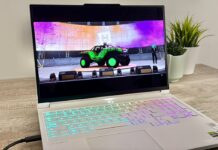
Microsoft didn’t overhaul much with the Surface Laptop 4, but if you’re looking for a Windows laptop that does particular things right, this is a contender. Naturally, there are a lot of Windows laptops available, so it’s not like you don’t have options. Except the Surface line continues to make things interesting.
I never got a chance to use the Surface Laptop 3, and have no basis for comparison that way. I can’t tell you whether the 4th-gen is that much better. What I can tell you is whether this is a Windows machine worthy of your time and money. Microsoft’s focus on smart design and functional utility come together to make it compelling, and here’s why.
Microsoft Surface Laptop 4 (as tested):
|
Familiarity in the Surface Laptop 4
There are times when going with simplistic design principles works against a laptop, but this isn’t one of those cases. Microsoft wisely focused on not overdoing anything, leaning on tasteful treatments that actually make sense. If I was on the fence about one thing, though, it would be the felt around the touchpad. Not that it isn’t comfortable, it’s just too easy to get dirty, and too difficult to clean properly.
Apart from that, there’s a lot to like. The anodized aluminum finish is slick, as are the trackpad, keyboard and overall finish. My review unit had a 13.5-inch PixelSense display (2256 x1504) with the excellent 3:2 aspect ratio. Being a touchscreen, I had that convenience to go along with it, and I appreciated its clarity and vibrance. I do wish Microsoft found a way to cut down the bezels by stretching out the display to a full 14-inches, but it does blend nicely in darker themes or content. There’s also a 15-inch version of the Surface Laptop 4, in case you want to work with a larger screen.
There are both Intel and AMD variants for the processor, but I can only speak to the Intel Core i5 my review unit had. I can’t be certain whether it or the AMD Ryzen is the better chipset. What I can say is that the specs aren’t all that bad. The 512GB of internal storage is fine, though I would’ve liked more than 8GB of RAM for something of this calibre. If you do want upgrades on both those things, they are available.
What you can’t do much about is the ports, or whatever is left of them. Microsoft stuck with a pared-down port array made up of a single USB-C, single USB-A, headphone jack and Microsoft Connect (to charge the laptop). With no memory card slot, nor additional ports for other peripherals, including to connect to a monitor, you will need to get a hub to take of those things.

Software and performance
The 3:2 aspect ratio clarifies what the Surface Laptop is more adept at. For apps where vertical real estate matters, it’s perfect for working on documents, photos or looking at websites. For video, however, there’s no real getting around the fact widescreen movies and shows won’t look like they would with a 16:9 aspect ratio.
That’s fine if your needs are mostly about productivity anyway. When you’re looking at a premium laptop, you expect it to perform, and that’s exactly what happens here. Apps run smoothly and that movement applies nicely across the operating system. The only caveat is whether or not the base specs are good enough for you. If you multitask a lot with demanding apps, prioritize getting more RAM. When you know what you need, you’re likely to get something that works well for you.
What helps make that case is how good the keyboard and trackpad are. Not every laptop manufacturer gets this right, while others mess with it in ill-advised attempts to improve upon it. I found it really easy to acclimate to typing up articles, like this review, on it. There is no number pad, so if you deal with numbers a lot, you may want to look elsewhere for something that does, like the LG Gram 17. I’ve never been a fan of touching a trackpad to select over clicking, given all the false positives, but that’s an easy fix in the settings. That’s the only knock against it anyway, as it’s easily one of the best trackpads I’ve used on a Windows laptop to date.
Though not designed to work with heavy media files, like video and photos, this laptop can do those things. The catch is that rendering won’t be as speedy as it would be with a better graphics processor.

Things to consider
The size and weight are in enough of a sweet spot to not make the Surface Laptop 4 feel cumbersome in any way. The hinge is also nice and sturdy, with a reasonable tilt backwards. While you might get a little glare working with it outside, the screen’s brightness is pretty good at offsetting that.
The built-in speakers support Dolby Atmos, which is always nice if you’re watching content supporting it. Overall, the speakers aren’t bad at all, but I did wish they could go a little louder when watching a playoff game outside. You may find them acceptable for indoor use, but just keep in mind they aren’t the loudest among similar models.
Microsoft oddly reduced the resolution of the Surface Laptop 4’s webcam to 720p—a downgrade from its predecessor’s 1080p camera. In a time when video conferencing matters more than ever, it’s a strange limitation that stands out. It does support Windows Hello for hands-free face recognition, so there is that at least.
Remember when I mentioned the ports? The USB-C port doesn’t support Thunderbolt 4, meaning you can’t use it to connect directly to an external monitor. You can use an adapter to make it work, so all is not lost on that. The issue is that the limited ports essentially force you to use adapters or hubs to be able to use a monitor and other peripherals.

Battery life
Microsoft didn’t put a huge battery under the hood here, so mileage can hit a wall. I found I could eke out about 10 hours per charge on it with mixed usage. However, it dropped if I worked a lot on editing photos or watched live sports with higher screen brightness outside. At one point, after a soccer game, NBA playoff game and tail end of an NHL playoff game, the battery sat at about 20%. That was from a full charge at the start.
It’s not just that, though. You will have to make determinations on when to prioritize battery life or performance in the laptop’s battery slider. I had to do it myself when using Lightroom and Photoshop to get them running smoother. I could push it further towards battery life, except processes would lag.
Those numbers are adequate, but far from exceptional for a laptop in this range. Charging it up is relatively quick, but with the proprietary charger, you need to keep it handy. You could use the USB-C port to charge it as well, which is convenient when you don’t need the port for anything else.
I didn’t notice it until later on, but the power adapter has its own USB-A port as well. It’s purely for charging phones, tablets and other devices. It doesn’t have any data transfer, so you can’t use it to plug in peripherals or anything else.
Final thoughts on the Surface Laptop 4
If you already have the Surface Laptop 3, you may not find much has changed here. If you’re in the market for a new Windows laptop, then know what you need it for most. Microsoft doesn’t try to make the Surface Laptop 4 something for everyone. It focuses on delivering performance with productivity taking precedence. What the company doesn’t mention is that you pay a price in battery life to get that. Not to mention the different chipset options between Intel and AMD to consider.
Would I recommend this laptop? Yes, but only if you’re in the exact wheelhouse it works best in. To my mind, that’s someone seeking to get work done, or desiring mixed usage, but not necessarily heavily focused on a more demanding creative field. For instance, if your job requires a lot of photo or video editing, I would suggest a model with a better graphics chip instead. If you plan on watching a lot of video on your laptop, take heed of this one’s aspect ratio. And if battery life is crucial to you, find something that lasts longer per charge.
The Microsoft Surface Laptop 4 is available now. Also make sure to read our blog post about Microsoft’s Windows 11 announcement to know everything about Microsoft’s new operating system.



